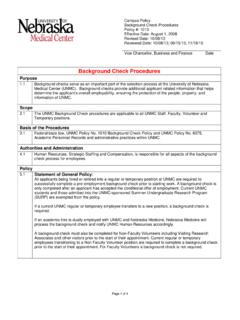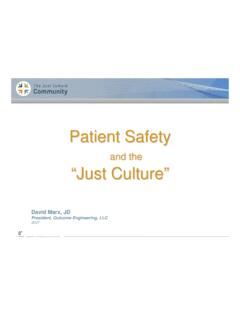Transcription of Insulin Insights - unmc.edu
1 10/3/19. Insulin Insights Vijay Shivaswamy, MBBS. Associate Professor Division of Diabetes, Endocrinology, and Metabolism University of Nebraska Medical Center/ Nebraska Medicine VA Nebraska-Western Iowa Health Care System Objectives u Evaluate diabetes treatment options available for intensifying therapy beyond oral anti-hyperglycemic agents u Identify patient and disease characteristics to establish appropriate individual glycemic targets u Identify current barriers to the use of Insulin therapy and provide strategies to overcome those barriers u Develop skills for calculating patients' initial Insulin dosage and titrating Insulin dosages based on individualized glycemic targets 1. 10/3/19. Case Study Mrs. K. u 50 yo Caucasian woman u T2DM 6y u BMI 31. u A1c , FPG 170, 2h PPG 202. u Metformin, Dulaglutide, empagliflozin u Healthy diet/exercise Question ADA recommends individualizing glycemic goals.
2 What is ' s target A1c ? u < u <7. u u u 2. 10/3/19. 5. Glycemic Targets: Standards of Medical Care in Diabetes - 2019. Diabetes Care 2019;42(Suppl. 1):S61-S70. 6. Glycemic Targets: Standards of Medical Care in Diabetes - 2019. Diabetes Care 2019;42(Suppl. 1):S61-S70. 3. 10/3/19. Question What is the most common reason to resist starting Insulin in a T2DM patient ? u Feelings of failure u Fear of hypoglycemia u Fear of weight gain u Fear of needles u Insulin causes complications Therapeutic inertia -intensification u Educate progressive nature of diabetes u Avoid using Insulin as a threat u Injectable agent (GLP-1 or Insulin ) after oral agents are done u Do not delay intensification of Rx is not meeting goals u Most patients who need an injectable medication, GLP-1. RA is preferred to Insulin . u Re-eval q 3-6 months and adjust 4.
3 10/3/19. Therapeutic inertia - Insulin therapy u Misconceptions of Insulin therapy u Lack of experience with managing Insulin regimens u Cost u Lack of time/ resources to optimize Insulin use Overcoming therapeutic inertia Insulin pens Cost Barrier u Great satisfaction u Consider human insulins (NPH/regular)-cost concerns, u Increases likelihood of taking relaxed A1c goals Insulin u Vial and Syringe u Great portability u Less reported pain u Social acceptability u Better accuracy 5. 10/3/19. 11. 12. 6. 10/3/19. 13. 7. 10/3/19. Current Insulin Options Type Basal Insulins Prandial Insulins Premixed Insulins Human U-100 NPH U-100 regular human Insulin U-100 70/30 RHI. U-500 regular human Insulin Technosphere inhaled Insulin Analog U-100 glargine U-100 lispro U-100 50/50 lispro U-100 glargine equivalent* U-100 aspart U-100 70/30 aspart U-100 detemir U-100 glulisine U-100 75/25 lispro U-100 degludec U-200 lispro U-100 70/30.
4 U-200 degludec degludec/aspart U-300 glargine Analogue insulins are associated with less hypoglycemia than human insulins, although these differences are not always statistically significant 15. *In the US, U-100 glargine equivalent is not approved as a biosimilar product. Singh SR, et al. CMAJ. 2009;180:385-397. FDA. Insulin Concentrations Concentration Units/mL Units/vial Units/pen 1000 300. U-100 100. (10 units per vial) (3 mL/pen). 600. U-200 200 Not available in vials (3 mL/pen). 450. U-300 300 Not available in vials ( mL/pen). 10,000 1500. U-500 500. (20 units/vial) ( mL/pen). Insulin pens significantly reduce the risk of dosing errors and hypoglycemic events Pens completely eliminate the need for converting doses based on the volume of Insulin injected Dosing errors with U-500 Insulin vials are common and dangerous but can be avoided with newly available pens 5-fold higher Insulin dose relative to the same volume of a U-100 Insulin 16.
5 Newton C, et al. AACE Annual Meeting. 2013 [abstract 271]. Segal AR, et al. Am J Health Syst Pharm. 2010;67:1526-1535. 8. 10/3/19. Question Mrs. K and you decide starting a basal Insulin . What is the initial dose ? A. 10 units B. u/kg C. 1 unit/kg D. 3 units/kg E. A or B. Initiation of Basal Insulin u Initiate Insulin with a single injection of basal Insulin u Bedtime or morning long-acting Insulin OR. bedtime intermediate-acting Insulin u Daily dose: 10 units or units/kg 9. 10/3/19. Question Mrs. K started 10 units Insulin glargine. FPG goal is < 130 and she plans to start SMBG. What instructions would you give to Mrs. K to titrate the Insulin ? u Decease by 2 units every 3 days u Increase by 2 u every 3 days u Increase by 4u every 7d u Increase by 8 u every 14 d if FPG > 180. u Only Mrs. K's provider should be titrating the dose.
6 Titration Basal Insulin u Patient self-titration is effective. u Increase 2 units every 3 days to reach FPG without hypoglycemia u Continue regimen and check A1c q3. u If hypoglycemia, address cause, reduce dose by 10-20%, and reassess u Once you start Insulin , TITRATE. 10. 10/3/19. Treat to Target Diabetes care 2010;33:1176-1178. A: Incidence of hypoglycemia in the per-protocol population receiving Insulin glargine algorithm 1 ( ; n = 2,315) or algorithm 2 ( ; n = 2,273). Melanie Davies et al. Dia Care 2005;28:1282-1288. 2005 by American Diabetes Association 11. 10/3/19. Summary u 3 mo f/u of Mrs. K. u Metformin, Dulaglutide, empagliflozin, and Insulin glargine 28 units QHS, A1c u FPG 118. u No s/s hypoglycemia Summary u Type 2 DM progressive disease u Individualize patient's glycemic goals u Consider GLP-1 RA as first injectable u Initiate appropriate basal Insulin u Patients can self-titrate basal Insulin 12.
7 10/3/19. Case Study u Mr. L. u 50 yo Caucasian man u DM 10 yrs u H/o CAD s/p CABG. u BMI 43. u A1c , FPG <130, 2h PPG 220-250. u Metformin, acarbose, empagliflozin, Insulin degludec 35 units QHS. u Struggles to lose weight u Exercises 3/week Question u A1 goals ? u <8. u < u <7. u < 13. 10/3/19. Why care about reaching goals ? Impact of Intensive therapy for Diabetes: Summary of Major Clinical Trials Study Microvasc CVD Mortality UKPDS . DCCT / EDIC* . ACCORD . ADVANCE . VADT . Kendall DM, Bergenstal RM. International Diabetes Center 2009. Initial Trial UK Prospective Diabetes Study (UKPDS) Group. Lancet 1998;352:854. Holman RR et al. N Engl J Med. 2008;359:1577. DCCT Research Group. N Engl J Med 1993;329;977. Nathan DM et al. N Engl J Med. 2005;353:2643. Gerstein HC et al. N Engl J Med. 2008;358:2545.
8 Long Term Follow-up Patel A et al. N Engl J Med 2008;358:2560. Duckworth W et al. N Engl J Med 2009;360:129. (erratum: Moritz T. N Engl J Med 2009;361:1024) * in T1DM. 14. 10/3/19. Question What is the next best Rx ? u GLP-1 RA. u DPP-4i u Premixed Insulin u Basal/bolus Insulin u Any of the above GLP-1 or Insulin ? GLP-1 RA Insulin u Patient preference u High A1c (> 11%). u A1c lowering u s/s catabolism (weight loss, polyuria, polydipsia). u Frequency of injection u ? Type 1 possibility u Established CVD risk benefit 15. 10/3/19. Case Study Mr. L now has A1c , FPG < 120, PPG 180-200. On basal + GLP-1RA. What next ? A. Increase basal Insulin B. Split basal Insulin C. Basal premixed BID. D. Add prandial to evening meal E. C or D. Prandial Insulin If A1c > goal despite optimizing basal u Titrate by 1-2 units or 10-15% twice weekly Insulin titration and FPG at goal until goal u Add prandial with biggest meal u SMBG before and 2 h post u 4u or 10% of basal dose u Address hypo cause u A1c <8%, consider lowering TDD by u Reduce by 10-20%.
9 4u or 10%. u Stepwise addition of prandial Insulin . better patient acceptance, lower hypo than full basal/ bolus u Addition of prandial use SMBG or CGMS data 16. 10/3/19. Premixed Insulin Benefits Disadvantages u Simple u Higher risk of hypoglycemia and weight gain u Convenient u Less flexibility u Basal/bolus in one medication Initiation/ titration Insulin na ve patients-10-12 units or u/kg Existing basal/ bolus unit to unit conversion Titration: 1-2 unit or 10-15% once or twice weekly until goal Percentage of subjects achieving HbA1c target values at the end of the study. Philip Raskin et al. Dia Care 2005;28:260-265. 2005 by American Diabetes Association 17. 10/3/19. Summary u Intensifying therapy to meet glycemic targets can reduce microvascular complications u When prandial Insulin is necessary, start with one dose of prandial Insulin with main meal and titrate as needed to prandial Insulin with all meals u If less complex therapy is needed, switch basal to premixed Insulin Newer/concentrated insulins 18.
10 10/3/19. Case u 62 yo obese man; 8 yr h/o T2DM and CVD . u Oral meds and 90 units U100 glargine qhs. u FBS 112-130, A1c %. u Reports 1-2 episodes of nocturnal hypoglycemia/ week. Options ? A. Decrease dose of U100 Glargine B. Switch to U300 Toujeo C. Switch to Degludec (Tresiba) (U100 or U200). D. No changes E. B or C. Insulin Degludec 100 unit/mL and Insulin Degludec 200 unit/mL PK Profiles . Pharmacokinetic Profiles at Steady State (Mean). Insulin Degludec Serum 10000 Insulin degludec 100 unit/mL. Concentration (pmol/L). Insulin degludec 200 unit/mL. 8000. 6000. 4000. 2000. 0. 0 4 8 12 16 20 24. Time Since Injection (Hours). N=33 patients with T1DM; units/kg given once-daily with Insulin aspart at mealtimes . Primary objective of the study was to compare Insulin degludec 100 unit/mL and 200 unit/mL PK/PD properties under steady state conditions.










